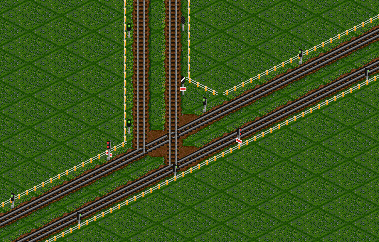
You could do this only inside the signal look-ahead distance but this creates the risk of inconsistent pathfinding. The trouble with this is that it makes the track cost a function of the instantaneous state of the vehicle which is problematic for the segment cost caching which is used outside of the signal look-ahead distance. So, I think there should be two different station penalties To make this work the cost of the centre track is artificially made more expensive than the cost via the platform but less expensive than the cost via the platform when occupied.
OPENTTD PATH SIGNALS FOR FREE
You can change a signal's direction for free by selecting the matching signal type and then clicking on the signal. Now, unless you have built a standard path signal, only trains coming from the direction the signal faces will be able to pass it. Click again to convert your signal to a one-way signal. I love trains and OpenTTD (although I dont play that anymore). Path signals always face one direction only. I happen to use a similar layout frequently in my own games, except that going via the platforms is the normal path, and the centre track is only used for bypassing trains when the platform is occupied. Convert the image to grayscale using an adjustment layer. The problem here is that the cumulative rail_pbs_cross_penalty cost of the occupied centre track is too small to make the centre path more expensive than going via the platform. As station platforms are always reserved either not at all or in their entirety, the total penalty is proportional to the platform length, and is predictable. Rail_pbs_station_penalty is the per-tile for a reserved station tile. Korean signals & markers NewGRF for OpenTTD. Contribute to KoreanGRF/KoreanSignalSet development by creating an account on GitHub. In this type of layout, if you are unlucky you could have different behaviour for short trains blocking the middle track than for long ones. Korean signals & markers NewGRF for OpenTTD. In many cases the total cost is different depending on how long the train is and how far away it is from the signal it is approaching. Rail_pbs_cross_penalty is the per-tile penalty for a reserved non-station tile. To show the concept, a traffic light has been added to each track. Once you have selected a signal type, position your cursor over the. Safe waiting positions are - by definition - in front of signals, depots and track ends. The Path signals are red by default, and will only show green as soon as a train can reserve a path to the next safe waiting position on its route.

The length of the train is such that it almost covers three segments of the circle. You may change the dragging signal density by clicking the small arrows on the button. The two new signal types behave a bit differently than standard OpenTTD signal types.

Two waypoints are used to keep it moving. Rail_pbs_cross_penalty and rail_pbs_station_penalty. It is divided into four segments using path based signals. To follow on from earlier comments, there are two further YAPF penalties which need to be considered for this type of layout:


 0 kommentar(er)
0 kommentar(er)
